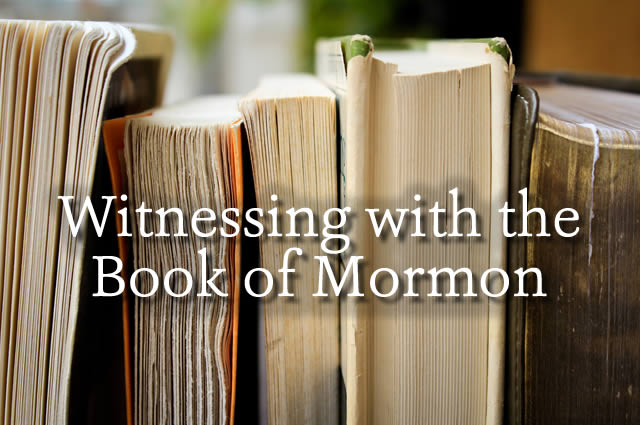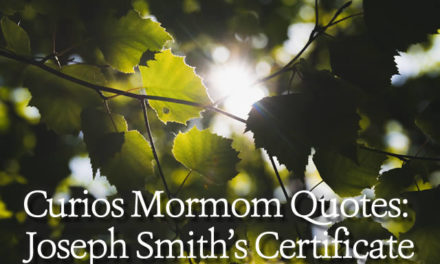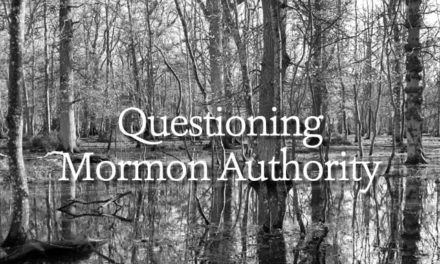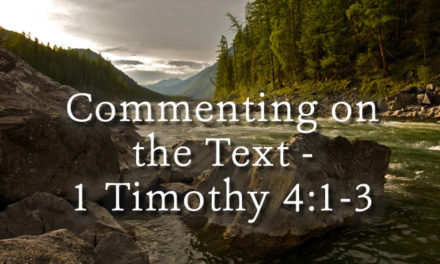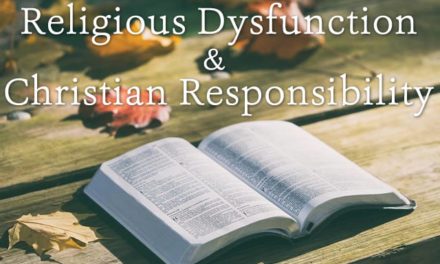Over 60,000 Mormon missionaries meet daily with people to whom they present their “gospel.” The keystone of that gospel is the Book of Mormon. It is what the prospective convert, or investigator as they call them, is supposed to read, pray about, and then on that basis decide whether or not Mormonism is true.
That will be the most likely topic of discussion when you have the opportunity to share your faith with a Mormon. You can certainly witness effectively using other topics such as their priesthood claims, false prophecies of their leaders, or the gospel and other doctrines. However, it will be you who must raise those topics, not the Mormon.
The Mormons will ask you to read the Book of Mormon and pray about its truthfulness as a test of its credibility. What better opening would you wish for?
This article will be based on the witnessing manual that Watchman Fellowship offers by the same name: Witnessing With The Book of Mormon. Our witnessing manuals are designed to demonstrate by photostats from primary sources that the teachings of counterfeit Christianity are not worthy of belief.
In a discussion with any religious group the primary issue is one of authority. Where do they find truth. And, who is speaking that truth?
For the Mormon truth is found in the Church of Jesus Christ of Latter-day Saints, and its General Authorities, as well as the Book of Mormon and their other scriptures.
Therefore, to arrive at the place where the Mormon is open to the gospel, credibility must cease being given to Mormon authority. That brings an opening to point to Jesus and the Gospel.
It isn’t enough to just tell someone from the Church of Jesus Christ of Latter Day Saints that Joseph Smith prophesied falsely, for open eyes and heart they must see, for themselves that the Book of Mormon is not from God as they had been led to believe. Or, they must see that the General Authorities are false prophets that fail the test of Deuteronomy 18.
Giving pages of quotations from false prophecies will not make an impact if it is disregarded as “anti-Mormon” writing. Often the more effective way is to show proof from their own books.
Earlier editions of the Book of Mormon can be compared to the currently used edition to show the many changes that have been made. Show how even the BOM they use contradicts LDS teaching, is internally contradictory, and is rejected by all non-Mormon historians and archaeologists.
Because the LDS Church is historically and psychologically based upon the Book of Mormon the effect of its discrediting will be significant to an opening for the gospel.
SECTION ONE:
Claims and Importance
Much has been said by Mormons over the years about the foundation of the Book of Mormon to their message. It is of first importance to them; only one other thing supposedly predates it. That is the First Vision where God supposedly told Joseph Smith not to join any of the churches but the restore the true church.
After this they claim the Angel Moroni led Joseph to the site in the Hill Cumorah where the gold plates were to be found, which contained the text of the Book of Mormon.
Orson Pratt, one of the original Mormon Twelve Apostles, said in Divine Authenticity of the Book of Mormon (page 1, 1850), “This book must be either true or false. If true, it is one of the most important messages ever sent from God to man,… If false, it is one of the most cunning, wicked, bold, deeplaid impositions ever palmed upon the world, calculated to deceive and ruin millions who will sincerely receive it as the word of God,”
He said further, “If after a rigid examination, it be found an imposition, it should be extensively published to the world as such; the evidences and arguments on which the imposture was detected, should be clearly and logically stated, that those who have been sincerely yet unfortunately deceived, may perceive the nature of the deception, and be reclaimed, and that those who continue to publish the delusion, may be exposed and silenced, not by physical force, neither by persecutions, bare assertions, nor ridicule, but by strong and powerful arguments – by evidences adduced from scripture and reason.”
This statement by Orson Pratt is both our invitation and guide. We must now present the “evidences and arguments” revealing the Book of Mormon.
The first question is how was it received? As stated above Joseph Smith was directed by the Angel Moroni to the place in the Hill Cumorah where the gold plates were buried. (By the way, did you know that Moroni is the capital of the Comoro Islands located off the southeast coast of Africa? Comoro Islands or Hill Cumorah. Moroni, the city, or angel. Coincidence?)
On those plates the content of the Book of Mormon was supposedly written in Reformed Egyptian hieroglyphics. This is a language, the existence of which is not supported by any evidence whatsoever. When Joseph Smith had to translate the hieroglyphs he resorted to a method of divination called glass-looking.
David Whitmer, one of the Three Witnesses to the authenticity of the Book of Mormon, said in his book An Address To All Believers In Christ (page 12), “I will now give you a description of the manner in which the Book of Mormon was translated. Joseph Smith would put the seer stone into a hat, and put his face in the hat, drawing it closely around his face to exclude the light; and in the darkness the spiritual light would shine.
A piece of something resembling parchment would appear, and on that appeared the writing. One character at a time would appear, and under it was the interpretation in English. Brother Joseph would read off the English to Oliver Cowdery, who was his principal scribe, and when it was written down and repeated to Brother Joseph to see if it was correct, then it would disappear, and another character with the interpretation would appear.
Thus the Book of Mormon was translated by the gift and power of God, and not by any power of man.”
On the first page of Watchman’s witnessing manual is a quote of Joseph Smith describing the result of this divine dictation. He said, “…the Book of Mormon was the most correct of any book on earth, and the keystone of our religion, and a man would get nearer to God by abiding by its precepts, than by any other book” (History of the Church, Vol. 4, p. 461. Also, found in the Introduction of every current edition Book of Mormon.)
There are three things in this quote worth discussing. That it is the “keystone” of the Mormon faith has already been discussed. That it is the “most correct” will be discussed later in this article. But the statement that “a man would get nearer to God by abiding by its precepts than by any other book” should be examined.
The doctrines of Mormonism have evolved over the years. The Mormon would say that is because they have a prophet. The individual Mormon, however, is not aware of the fact that Mormonism and the Book of Mormon teach radically different, and opposing, doctrines about God and salvation.
The Mormon doctrine of man’s progression to Godhood came years after the Book of Mormon was presented to the world.
Also, the doctrines of baptism for the dead and celestial marriage, which are part of that progression to Godhood, were developed later.
To the Latter-day Saint these two rituals are absolutely essential to their concept of salvation, or, “getting nearer to God.” If they are so essential why are they not found in the Book of Mormon? Or, was Joseph Smith incorrect when he made his statement (see bolded text above)?
The bottom line is that the Book of Mormon, the “keystone” of their religion, does not teach their doctrine. It would be like leaving out the resurrection of Christ from the New Testament. In fact the Book of Mormon teaches against their doctrine in many places, some of which we will discuss later.
Absurdities, Contradictions and Impossibilities
On the second page of the manual is a photocopy of Alma 7:1-10 in the Book of Mormon. In verse 10 the text says, “And behold, he shall be born of Mary, at Jerusalem which is the land of our forefathers, she being a virgin, a precious and chosen vessel,…”
The Book of Mormon contradicts the Biblical account of Jesus’ place of birth being Bethlehem. The Mormon will say that Bethlehem and Jerusalem are just a few miles apart and Bethlehem is a very small town compared to Jerusalem therefore it is not inappropriate to call this ‘suburb’ by the name of its larger neighbor. And the verse does say “land of” so it need not mean within the city walls of Jerusalem.
However, Bible is much more precise than this. When it comes to prophecy, generalizations do not pass the test of prophetic accuracy. When a place is named in prophecy that place, and only that place, is meant.
To illustrate this the prophecy in Micah 5:2 of Jesus’ birth names the village of Bethlehem Ephrata. This was done to differentiate it from another Bethlehem in Zebulun named in Joshua 19:15. Biblical prophecy is not like horseshoes and hand grenades.
On the third page of the manual is this interesting statement from Alma 46:15. “…yea, all those who were true believers in Christ took upon them, gladly, the name of Christ, or Christians as they were called, because of their belief in Christ who should come.”
At the lower right corner of this page in the Book of Mormon is the date 73 B.C.. The problem is that in Acts 11:26 we are told, “And the disciples were called Christians first in Antioch.” The Bible says believers were called Christian FIRST in another place and over a century later.
Also, the word Christian is from the Greek word Christos. If the Book of Mormon was written in Reformed Egyptian why do we find a Greek word in the text?
On the fourth page there is a theological problem for the Mormon. Mormonism today is polytheistic. The LDS Church teaches that you can become a God and rule your own earth someday if you keep all the laws and ordinances of the Mormon gospel. The problem for them is that the Book of Mormon was written before their theology evolved from the monotheism in the Book of Mormon to the polytheism of today.
That polytheism is illustrated in Mormon Doctrine written by Apostle Bruce R. McConkie. On page 576, under the title Plurality of God he says, “Three separate personages – Father, Son, and Holy Ghost – comprise the Godhead. As each of these persons is a God, it is evident, from this standpoint alone, that a plurality of Gods exists. To us, speaking in the proper finite sense, these three are the only Gods we worship. But in addition there is an infinite number of holy personages, drawn from worlds without number, who have passed on to exaltation and are thus gods.”
The monotheism of early Mormonism is illustrated by this statement from Alma 11 in the Book of Mormon. “And Amulek said unto him: Yea, if it be according to the Spirit of the Lord, which is in me; for I shall say nothing which is contrary to the Spirit of the Lord.” So Amulek is about to speak the truth, and nothing but the truth.
“And Amulek said: Yea, there is a true and living God. Now Zeezrom said: Is there more than one God? And he answered, No. Now Zeezrom said unto him again: How knowest thou these things? And he said; An angel hath made them know unto me.”
The Book of Mormon says there is one God. The Mormon Apostle Bruce R. McConkie and the LDS Church today say there are many Gods. What is the truth? The Mormon you share this information with must answer the question. An aid to that end might be found in Isaiah 43:10 and 44:6-8.
On page five of the witnessing manual there is an interesting scene from Ether 15:30-32, that is worthy of Hollywood’s special effects people. It says, “And it came to pass that when Coriantumr had leaned upon his sword, that he rested a little, he smote off the head of Shiz. And it came to pass that after he had smitten off the head of Shiz, that Shiz raised up on his hands and fell; and after that he had struggled for breath, he died. And it came to pass that Coriantumr fell to the earth, and became as if he had no life.”
Mormons challenge people to accept the divine origin of the Book of Mormon. One method they have used is to list all the things that would make writing such a book difficult and then ask how an uneducated young man could have done it.
This challenge is reproduced on page seven of the manual from a pamphlet distributed at the Los Angeles Temple Visitor’s Center. One of the challenges it makes is #19, that “The book must not contain any absurd, impossible, or contradictory statements.” The scene described above is an absurdity.
Corrections Needed in the “Most Correct Book”
On page six of the manual Joseph Smith tell us that he, Oliver Cowdery, and David Whitmer, were visited by an angel who told them, “These plates have been revealed by the power of God, and they have been translated by the power of God. The translation of them which you have seen is correct, and I command you to bear record of what you now see and hear” (History of the Church, Vol. 1, page 55).
The point is clear; Mormonism teaches the Book of Mormon is an accurate translation from the golden plates. There are no mistakes, they say.
On page seven of the witnessing manual the above mentioned pamphlet from the L.A. Visitors Center says at point #6, “Other than a few grammatical corrections, you must have no changes in the text. The first edition as you dictate it to your secretary must stand forever.”
This is easily verified today, thanks to the LDS Church and Wilford Wood. In 1980 the LDS Church published the Sesquicentennial Edition of the Book of Mormon, an exact reproduction of the original 1830 edition of the Book of Mormon which could be purchased inexpensively at all LDS bookstores. Also, Wilford Wood published his two volumes Joseph Smith Begins His Work which was a photomechanical reproduction of the original 1830 Book of Mormon. This is available today in LDS bookstores.
So, has the Book of Mormon stood forever as dictated to Smith’s secretary, and as the angel proclaimed? No!
On page eight of the witnessing manual the 1830 Book of Mormon (Mosiah 21:28) says, “and now Limhi was again filled with joy, on learning from the mouth of Ammon that king Benjamin had a gift from God, whereby he could interpret such engravings; yea, and Ammon also did rejoice” (underlining mine).
However, in the current editions of the Book of Mormon it says the same as the above with the exception of Benjamin. That name was dropped and changed to Mosiah. This is shown on page nine of the manual. The reason for the change may be that in chapter six King Benjamin died after reigning as king for three years. However, the dates given at the bottom of the page in both chapters is “[about 121 B.C.]” so the reason for the change is not conclusive.
The thing that is conclusive is that a significant change was made without notation and in contradiction to the claim made above that it would stand forever unchanged.
On page 10 of the witnessing manual the Book of Mormon prophet Nephi is quoted from the 1974 edition of the Book of Mormon, “…and many generations shall not pass away among them, save they shall be a white and delightsome people” (2 Nephi 30:6).
The Book of Mormon says the Lamanites were a tribe that traveled from Jerusalem to the Americas. In the Americas they became a sinful tribe whose skin turned dark because of their sin. This is taught in 2 Nephi 5:21, which says, “And he caused the cursing to come upon them, yea, even a sore cursing, because of their iniquity. For behold, they had hardened their hearts against him that they had become like unto a flint; wherefore, as they were white, and exceedingly fair and delightsome, that they might not be enticing unto my people the Lord God did cause a skin of blackness to come upon them.”
The LDS Church has taught that when the Lamanite would become righteous his skin would turn “white and delightsome.” The descendants of the Lamanites, the LDS Church teaches, are today the Native Americans. The Church sent its missionaries to the Indian reservations with the message that upon conversion to Mormonism their skin would begin to turn “white and delightsome.” This “paleface gospel” was not universally well received!
With the racial equality consciousness in the nation during the seventies the pressure built to change this teaching. The LDS Church was facing public opposition to its anti-black teaching, especially the athletic teams from BYU. The church leaders are very sensitive to public perception of Mormonism and felt they needed to respond.
Since a so-called “living prophet” leads the church, whose words are more important than the words of a dead prophet, the solution was obvious. A “revelation” (the Church never referred to it as a revelation but the Mormon people did) to Prophet and President Spencer Kimball was received that granted the priesthoods to blacks, thus removing the racial restriction.
However, the Church had a problem. The Book of Mormon teaches that when a Lamanite becomes righteous his skin turns “white and delightsome.” Should the Mormons now expect to see their black Mormon brethren begin to turn white? Obviously the Mormon Prophet and his Apostles did not believe in the Book of Mormon that seriously so they had to make a change there too. The “most correct book on earth” had to be “corrected” again.
On page eleven of the manual the same verse from the ‘corrected’ 1981 edition of the Book of Mormon cited above says, “… and many generations shall not pass away among them, save they shall be a pure and delightsome people.” The color white is now the moral quality of pure, a much less racially prejudiced statement.
This doctrinal adjustment involves the so-called ‘Curse of Cain’ teaching in which the blacks and other ‘colored’ peoples were cursed from holding the LDS priesthoods because of sin in their preexistence.
In 1978 this teaching was dropped with Kimball’s revelation and the priesthood was opened up to all the races
While we are on page eleven of the manual it should be pointed out that the time in which this statement was made in 2 Nephi is given at the bottom of the page as “[Between 559 and 545 B.C.].”
There is another problem you can point out on this page that appears in verse 5 of chapter 30. It says, “And the gospel of Jesus Christ shall be declared….” The Book of Mormon is naming the Messiah five and half centuries before His birth, and in the Greek form of His name, while the Book of Mormon was supposed to have been written in Reformed Egyptian!
On page 12 of the manual we read from the 1830 edition of the Book of Mormon at 1 Nephi 11:18, “Behold, the virgin which thou seest, is the mother of God, …” And again in verse 21 it says, “And the angel said unto me, behold the Lamb of God, yea, even the Eternal Father.”
On page 13 of the manual this passage continues at the top of page 26 in the original 1830 edition of the Book of Mormon. It says, “And it came to pass that the angel spake unto me again, saying, look! And I looked and beheld the Lamb of God, that he was taken by the people; yea, the Everlasting God, was judged of the world; and I saw and bear record.”
These passages from the Book of Mormon are talking about Mary and Jesus. Mormons today do not believe Jesus is the “Eternal Father,” nor do they believe that Mary is the mother of God in the common use of that term. The original edition of the Book of Mormon needed ‘correcting’ at these points. So, in the current editions of the Book of Mormon these passages all have “the Son of” inserted at appropriate points to make them ‘correct’.
Early Mormonism taught a modalistic concept of God. Modalism teaches that God is just one Person who is the Father at one time, the Son at another time and the Holy Ghost at another.
That this was true of early Mormonism is seen in the modalistic teaching of many of the Mormon splinter groups who derived their theology from early Mormonism and the 1830 Book of Mormon before it was “corrected.”
On page 14 of the manual verse 18 above now says, “…Behold the virgin whom thou seest is the mother of the Son of God,…”
Verse 21 now says, “Behold the Lamb of God, yea, even the Son of the Eternal Father!”
Verse 32 now says, “…yea, the Son of the everlasting God was judged of the world.” (Underlining mine)
This addition to the text is a very important and substantive change from the original 1830 edition.
When the Book of Mormon was supposedly translated by Joseph Smith from the gold plates the translation was declared to be accurate. Any changes since the original edition are said to be minor such as the correction of typos, but nothing of a doctrinal nature. Obviously this is not true. The first edition has not stood forever as the Mormon church has claimed.
These changes are also dishonest. If a change is made honesty requires a footnote. However, no one is permitted to change the very words of God, unless they are not really the words of God.
Maybe that is the conclusion we should reach.
If so, then, “…it should be extensively published to the world as such: the evidences and arguments on which the imposture was detected, should be clearly and logically stated, that those who have been sincerely yet unfortunately deceived, may perceive the nature of the deception, and be reclaimed, and that those who continue to publish the delusion, may be exposed and silenced. Not by physical force, neither by persecutions, bare assertions, nor ridicule, but by strong and powerful arguments – by evidences adduced from scripture and reason” (Divine Authenticity of the Book of Mormon, by Orson Pratt).
By David Henke

